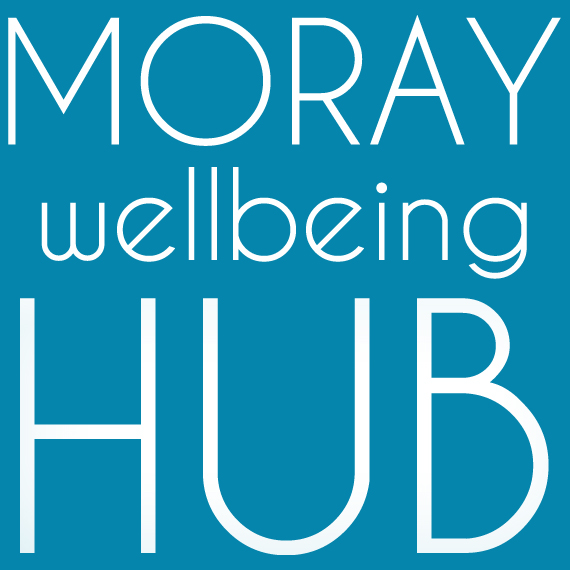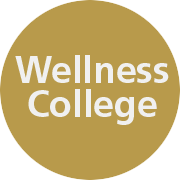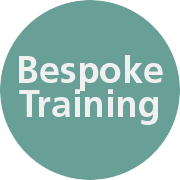As part of We Make Moray (the local culture strategy) representatives from Moray were invited to apply to take part in a peer learning event to Dumfries and Galloway. Moray Wellbeing Hub CIC’s Heidi Tweedie was delighted to be selected for the trip as part of the health and wellbeing sector representation and shares her reflections on the trip.
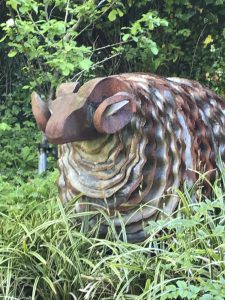
Cheeky sheep delights at Catstrand
The aim of the visit was to focus on working in partnership across the different sectors in line with Moray’s Cultural Strategy and to support the recently announced Economic Strategy for the area. Other participants included representation from Earthtime, the farming community, Health and Social Care Moray, Moray LEADER, tsiMORAY, WDC Scottish Dolphin Centre (Spey Bay), Findhorn Bay Arts and an independent artist.
“We Make Moray is a partnership project that aims to support the arts and culture sector in Moray. It does this by supporting individuals, organisations and communities to develop, connect and celebrate creative and cultural activity in Moray. The work is guided by the ambitions of the Moray Cultural Strategy and is currently funded by Highlands and Islands Enterprise and Creative Scotland.”
For Moray Wellbeing Hub such a visit fits with our desire to connect and collaborate locally and nationally in ways that improve the mental health of people in Moray, especially those facing disadvantage and vulnerability. Although many of the partners attending were known to us, such a trip provides a concentrated way to share ideas and build trust. Our hopes for this trip were to do just that, to come back home with renewed ideas and energy, new colleagues and friends, and to have already begun to build projects for the future.
Day 1: CatStrand – Brian Edgar
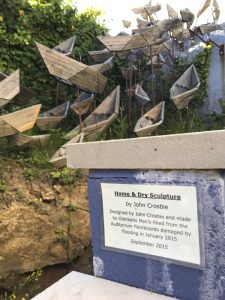
Beautiful art links to the storms of the past
Named after the burn behind the building CatStrand was started in 2007 as part of the Glenkens Arts Company which was looking to do something with a local school. There had been a community survey which overwhelming said something needed to be done with the derelict school in the centre of the village. Now they have 18 paid staff through their projects and are developing a new project linked to youth work, “there are so many projects here there is not a moment it’s empty, plus we do private hires too.” They also have a transport initiative running a number of minibuses – they started with 1 and now have 7 – 3 are their own and 4 they run on behalf of the council. As well as the usual hiring to groups they also do hospital transport meaning that their transport initiative is making a profit.
The CatStrand shop and café is open 7 days only closing over Christmas, where most other galleries are closed over the winter their busiest months are Feb and November. There is regular custom from local people for the shop and café, plus they have a 5-star rating for tourism too.
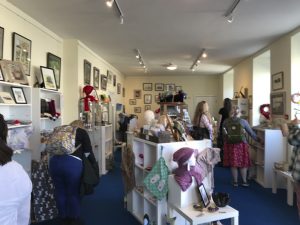
Catstrand shop
Their area covers four parishes of about 2 thousand people, and beyond that Ayr and Prestwick people will travel in for events. They have found that acts would prefer to come here rather than Glasgow as the venue is more intimate, in fact they were nominated by artists for the Trad awards as a favourite venue because of this unique selling point. The building’s set-up is also very important to the success of the venue; their auditorium seats 90 people and had good heat recovery system and acoustics.
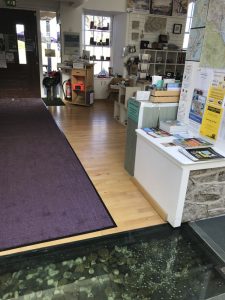
catstrand shop and below foot a window to the past
The team’s second Brian (Jones) has a focus on community development. Initially, his work started with older people, including around setting up a Men’sShed. As a result, the men that go to this then go on to other groups. This work has widened to all ages, they have a youth arts officer 3 days a week and this work includes a youth drama group that is award winning. The young people’s work is funded by the local Hollywood Trust and Creative Scotland, they have kids travel as far as from Stranraer an hour away for things like their animation courses.
Brian Ross then shared on the Connecting Communities project funded by LEADER and Big Lottery. This was about social isolation and it was the catalyst for groups such as the Men’s Shed and their Ukulele group.
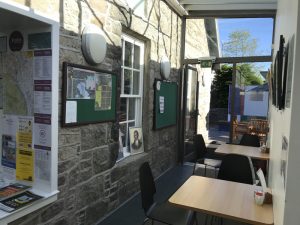
walking about Catstrand
To support connection existing and new groups can use CatStrand spaces for free and then support the building by buying a cuppa afterwards. At the end of this funding the independent evaluation they commissioned showed people 25-55 were in clear need of similar support. This led the project to expand wider toward intergenerational work including projects such as grannies and grandkids cookery sessions.
Some other great ideas from the CatStrand team:
- Through their arts project they are trying to get the local halls who have their own volunteers to run their own festivals with them giving financial support.
- Getting under 25s involved had been a challenge but now they have introduced a blanket £4 for any event. Also, the family market is something they are looking to draw in.
- Free pizza if you volunteer! this is a great idea for all the young people work.
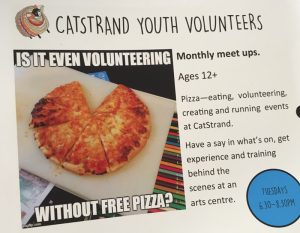
Catstrand use pizza as a tool of engagement!
- They have a system where if 6 people in a community want to go to something they will send the community transport. This benefits the bar takings as they are not driving!
- Used wishing trees to gather what people wanted from an area to encourage people to write up things.
- Visual artists are supported by a gallery space which is changed every 2 months. In the past, they have been able to offer commissions to local artists.
- For new activities and groups, their format is to try 6 weeks taster for free and if it takes off they then pay after.
- Their work closely with the local HSC and the likes of the Food Train. They are also working with the local college to create local campuses and courses in collaboration.
- The ‘Bleather Bus’ – an actual kitted out bus that travels round to the smaller communities to provide a space for conversation and group activity.
-
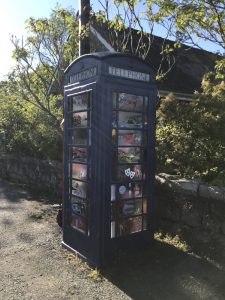
Arty phonebox now focus for young people & health info point
Doing up the phone box beside the venue (see photo) was a great idea. This was a project with young people and provides a place for them to hang out in an evening and is stocked with information leaflets as well as a charging point for phones.
Heidi’s reflections: “For me a powerful aspect of the CatStrand team was the focus on using what you have, being diverse and making the very most of it but not forcing things. The team were local and diverse in age and experiences, there did not seem to be a hierarchy in the team – they looked to celebrate their strengths and work together. I loved the idea of the phone box and in chatting to others I can see this working in Moray to include bus stops or public loos…perhaps even put wifi in there!”
Day 1 – Frank Hayes, ‘Art For Enjoyment; accessible art for all’
Frank joined us for dinner that night and shared his experiences of running this innovative social enterprise. There are various versions of his format for painting, photography and print making. His classes happen weekly and people don’t need to book, this suits those who attend as they can dip in and out flexibly. His painting class has up to 45 people of all ages and he arranges regular exhibitions, curated to ensure every participant has one piece of work, no matter how complete, displayed publicly.
This inclusive practice, where everyone attending is seen as an artist without any labels of age or life challenges, is making a big impact; he shared some stories of the diversity he sees at the classes and how that affects their wellbeing – the 7 year old who gets to see his work displayed alongside adults that he looks up to, the teenager with autism who is accepted by the class as a fellow artist but elsewhere is less able to feel acceptance and the shift nurses who get to look after themselves with a class whenever they are free.
He also spoke about those who move to the area and struggle to connect in locally being a market he’s keen to reach. Those in the working age group who are not from the area and want to connect and put down roots. In this regard he’s also had success and feedback from participants that the approach works for them this way, with a health professional sharing with him that he had finally made new friends after moving to the area for his job as a result of the courses.
Frank was very clear that he charges for the course and that his approach is a true social enterprise (as a Community Interest Company) not a charity model. Costs to participants are made further affordable whenever he works with specific client groups where he has managed to get some grant funding, plus he will do consultancy work with large organisations and corporations that help toward the same aims. He shared his experience of working with Glasgow charity Whizz Kids that work with young people who use wheelchairs and the amazing inclusion of seeing every young person being able to add their mark to a work of art. The end product of this in a Kandinsky style was so powerful and popular it has now ended up hanging in the First Minister’s office after she spotted the work at their event.
Heidi’s reflections: I loved chatting with Frank and our fellow We Make Moray peers about his ideas, there were a great number of parallels between his approach the way we work at Moray Wellbeing Hub with our ‘Wellness College’. Being a social enterprise is a very important part of both our approaches in terms of creating change and making activity that connects people inclusive; it sounded like he had some great ideas on how to make this work with a regular class structure for arts activity. I think a collaboration is worth exploring further between our organisations.
Day 2: Creetown Initiative – Andrew Ward
In 2000 the local area was recognised to have challenges. Economically the focus was forestry, farming and in the past mining, as it previously had been a very wealthy area due to the local granite quarry. Some local people then formed Creetown Initiatives, starting their project work with a 60-hectare area of forest gifted by the Forestry Commission. In 2006 they moved on from being volunteer led and secured a full-time project worker role for a year. Andrew joined from having been involved at CatStrand and extended his role as a consultant to ensure funds for his role beyond that first year.
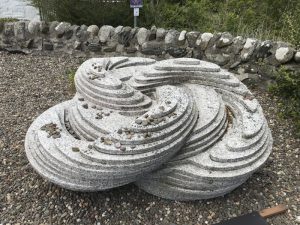
Art is everywhere in Creetown
Now employing 14 staff, they are big fans of development trust movement and using this framework to operate consultancy work right across Scotland with the bulk of their work focused on behalf of other communities to help them to build capacity.
In the area itself, a parish of 1k and a village of 650 people, they have been restoring buildings, delivering new services including a bee conservation project, building a playpark, and they have a car share project. They also as have youth work projects which have been successful, leading to starting work on a youth club for older people as realised that this was the main demographic in the area. They don’t charge but people are beginning to throw money in the pot themselves.
Car share project – They realised that in the village there was 40 cars that only get used once a month, mostly by retired people. A car share idea was born rather than alternative community transport approach. Andrew shared that he preferred carshare over community bus schemes as these can, unfortunately, sit empty a high percentage of the time. They also realised that young people could not get to work and therefore could not get into employment, so they got two scooters they could lend out for 6 months. Unfortunately, there have been challenges in subsidising the scooters with funding but there is interest in funding this again and currently, the car share is working well.
Kirkcudbright project – This is a very attractive place in the south of Dumfries & Galloway with lots of groups, but cross over and confusion meant they were not making any progress. Creetown Initiative got involved about 3 years ago and was able to help these disparate groups come together as a new development trust umbrella organisation for the area through consultancy support. They had some large buildings that were unused which are now in the process of becoming centres and venues. His tip is to use buildings for what they are already not try to make it something else (i.e. a church with a big space, “well use it for events that seat 300 plus not cut it in to bits like offices”.) To aid this work and get the information they needed from the local community they did an 8 page questionnaire that they hand delivered to every house and then came and picked them up – from this they got a good 80% of returns which is powerful in securing funding. Another example was the taking over of the local council owned caravan site, which since they took it over it has created a 50k surplus. They managed to use staff that were underemployed as part time at the local pool and give them the rest of their hours at the caravan park, a real success.
They key point here is at in other areas that are less interested in collaborative work they can look and see the approach that has worked for Kirkcudbright and be inspired. Andrew has been touring with talks on this, he is then able to sell their consultancy support if people feel they need this once they see how well it has worked for Kirkcudbright.
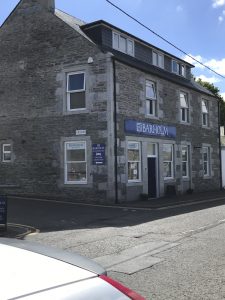
Artists shop and behind the luxury hostel all run by Creetown
Barholm Centre – Creetown Initiative took over a building that now hosts a number of businesses. Firstly, there is an artist’s shop that faces the high street. The rent is kept very low at around £25 per month and the artists take a turn to run the till as well as having a guest spot for other artists who are unable to be more fully involved. We spoke to Val who was manning the till that day. She said that she loved being part of the collective and as a result there were several benefits she could see for herself and others; she noted that all the artists had ‘upped their game’ as a result of having the focus of being able to display and sell their work, there were a number of artists with long term conditions who had been supported by their fellow artists to contribute, and she felt more connected as a local village member. It was really inspiring to hear about this and see a powerful community asset in action; there were tourist leaflets to the side of the counter a friendly face for folk to chat to. The artists are a cooperative they share a bank account and Creetown leaves them to run things as they wish, they just get paid the rent.
The second part of Bartec Centre was the accommodation which is a modern take on a bunkhouse with simple rooms serving up to 6 people per room. Then there is cycle hire and a charity shop.
Heidi’s reflections: “I was inspired by Andrew’s attitude of mutuality and collaboration, that when he consults for people that they learn as much from them as they provide. Networking is very important to him, trading knowledge and support. All of these things I could relate to. His attitude on personal responsibility through Creetown’s approach to offer the infrastructure for groups and then hand things on really resonated, “Artists don’t want that (i.e. running a building), they just want to get on.” For me I could see that we could adopt similar approaches to creating opportunities for people to come together to solve issues and us facilitate this process practically as well as with our softer support skills. I also related to the approach of squeezing as many different revenue streams and opportunities out of one project such as the Barholm Centre. The fact this can now run itself gives financial security as well as bringing tourists to the area and employment locally.”
Day 2: DG Unlimited – David McDonald
Joining us for lunch was David from DG Unltd – this is a legacy of the D&G place partnership from 2012 and a lack of leadership and resource for local authority and arts organisations. Out of this there was a lot of positives and organisations grew and blossomed, but still no one taking leadership for arts development and that was where they were created.
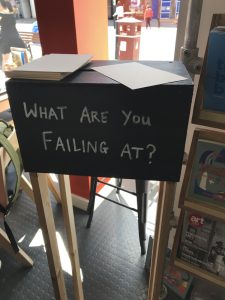
Questions to engage and connect while you have a cuppa at stove cafe
Day 2: Catherine Wheeler, The Stove Network
The Stove Network operate through a number of creative projects which include a café in Dumfries High Street as a focus. They do everything they can to have a conversation with the public and don’t talk about themselves as an arts organisation but as, “a membership organisation to hold and participate in conversation” – this even includes regularly changing the main sign on the front of the cafe and using their sign painting projects to create these. They have a long-term project to reimagine the town centre and got the council on side to see they needed people living in the centre of town by involving lots of people.
A few key notes of interest in how they work;
- “Acts of leadership rather than leadership sitting with any one person.”
- They focus on a programme of regular activity to build trust and showcase events and a responsive fund that is flexible to respond to need.
- “We don’t want to get bigger but we allow things to spinout from them”.
- Recognise the tension between freelance and salaried roles, have space for both but constantly return to explore this. “You don’t have to have answers but ongoing conversations”.
- The challenge of young people leaving for university and not coming back is one they are more positive about and they see a growing hope here.
- They just do it – not going to do lots of meetings, they try it and test it and seed conversations and see what takes. “It’s the pattern and process that can be replicated not the project.”
- Image of hub and spokes model, “We think of it much more like organisms.”
- As a group of 5 they are the creative director role. The full time member of the curatorial team is Matt Baker and he is the strategic voice. Every Monday they have a project meeting to allow all team members a voice, including the café staff.
-
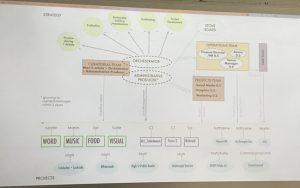
Stove Network Structure
Governance – a charity with trading arm and don’t rely on volunteers, almost always have some payment.
- Constantly changing their physical space.
- A mechanism to support the development of young talent – They have YP who have 1.5 days a week and are expected to link into other projects and also take up learning opportunities, clear to them which bits are paid and which unpaid.
- They always have food, skills, display elements for any projects, “A set of key ingredients.”
- Runs social media as an art project by an artist.
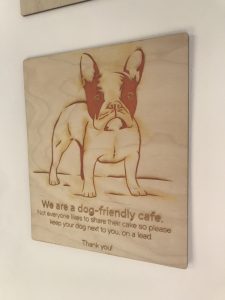
Stove cafe welcomes two and four legged customers
Heidi’s reflections: This was so useful and reassuring for me; the Stove Network’s mutual approach seemed the closest thing to Moray Wellbeing Hub that I had heard, there were so many echoes of our own exploratory thinking. When Catherine talked about, “constant is the process and ethos but what this looks like is different,” with things like having transparent conversations and recognising tensions between roles and new ways of supporting people to make different uses of spaces and themselves, I knew that we could look at what they achieved and learn more about how to communicate our own work.
Dani Rae, D&G Arts Festival
Dani had worked in the industry for years and returned home to curate this festival. It’s the 40th anniversary this year of the festival which started with farmers wives working together to bring classical music to the area and has grown from this volunteer base to a small full-time team.
She coordinates all the venues from backrooms of pubs to village halls. One of the ways they work is to underwrite the costs if people don’t clear from ticket sales. They had 40 applications for this Support for Ambition programme and only 7 claimed, up to around £1k. A key part of this is ensuring that the artists are paid appropriately. They also have a fringe where people can upload their own events to a website. Tech has not quite worked yet but it’s getting there. As a result of the rural nature, she has been better able to pass on responsibility to each area and enable them to make their own festival within their own parameters.
A big focus for her has been the wellbeing of local people – pride and not talent drain. She spoke about the challenges of using schools and churches, “Making it your space.” Taking spaces and making them something fresh such as a nightclub, “so it does not feel like that place where your auntie got married and perhaps you’ll come back again.” Use of schools to show theatre around topics such as transition was discussed and finance is a large part of this approach to grow capacity; they subsidise schools first time 50% and 25% for second for transport for touring productions.
A key point was about mentoring and relationships, young people are involved coproductively by making decisions including around the budget. Connecting young people for work experience and flexibility around this was important. As Dani pointed out, “young people are not just the audience of the future, they are the audience of now”.
Challenges discussed with the group included – volunteer fatigue, insurance challenges, last min nature of licences and funding clearing, booking far in advance when the processes don’t catch up. Umbrella organisations that can use up and end up competing for the very resource they are there to provide their members was discussed, as was the challenge of personalities rather than policies that are supportive of their work in decision-making bodies.
Heidi’s reflection: The practical aspects of what Dani shared were very interesting and it was great that she was able to take time out whilst the festival was on to meet with us all – clearly showing how organised things were and that the team were empowered to run events to plan.
Overall final reflections:
The team met on the morning of day 4 to put our next date in the diary and capture a few final thoughts. Reflecting before we left to journey back showed that there was much that we all agreed and learned from. For me this was about connecting things up to make viable sustainable businesses; projects do form but they are often disconnected. Using an economy of scale to provide infrastructure such as pay, training, transport, venues to let people do the bit they most love without fatigue. Balancing this economic model with a focus on process not output was also vital.
Others added their thoughts that it was about using creative tools to catalyse community connections in the areas that is there already, recognising there was a much to learn but that in Dumfries and Galloway their proximity to Glasgow and Edinburgh draws a great deal to them and they have area specific funding we don’t. People felt inspired by the connectivity and how organisations had made best use of resources, by the sheer choice in activity that seemed to be on offer. There were many more thoughts, even an idea around the Elgin ‘Dandy Lion’ that could be a great health promotion tool, but by this point we were all rather tired!
The conversations happening between us and the groups we visited helped us to understand and build relationships with each other and new Moray partners for the future. Big thanks go to those in the team who drove over the weekend, a not insubstantial task when you consider the distances involved. We returned Sunday dinnertime and for me I was inspired and felt more ‘tooled up’ to continue our work at Moray Wellbeing Hub, but it was very tiring and in future I will have to ensure I schedule in a few days rest before returning to the day to day of business as usual to let the learning sink in and regain my energy.
Two weeks post-trip :
The group met again for a cuppa and a chat in how we take things forward. It was great to see the group back together and look at what we can create from this amazing experience we shared for the benefit of Moray. For me I had already used the experience to inform discussions linking a community asset transfer looking to increase wellbeing in an area and bring in new partners from the group. I had also been able to share the approaches of The Stove Network and Arts for Enjoyment to fellow Champions working in similar ways.
Vitally it linked really well with our new project ‘Wellbeing Connected Moray’ funded by LEADER and Moray Drug and Alcohol Partnership, supporting vulnerable and disadvantaged people, as it aided us in thinking about the activity we are planning with our new team at a time of key planning and recruitment. The other great aspect to our meeting up was the peer support and the energy passed between us to support one another to seek resources to take forward new ideas.
For many of us this was a very personal learning trip and reminding us of our own creativity and the need to have this in our own lives, “It helps my own mental health and wellbeing to be creative… my daily role is more black and white, and it’s frustrating to see how creativity can better achieve outcomes in my role but the reality is different just now. I will just do more things outside my work to charge me creatively and resource me for my role.” Another participant shared, “Sometimes I lose faith in myself, but the energy of the trip gave me back my confidence and passion in creativity. I’m so grateful to get to know you all and look forward to being in projects together in the future.”
“Clearly things are happening in Moray, but this is about weaving things together like a tapestry and bringing them together,” Susan Morrison from tsiMORAY and our intrepid trip organiser reflected. Jo Campbell from Earthtime shared, “The other thing I took away was that volunteers need to have support to ensure they don’t get burned out, and to support people to realise that a creative approach is not about ‘good art’ but doing something for yourself and feeling good…finding ways to fund things and not excluding people based on cost and ensuring value.”
Michelle reminded us about the process and what she had learned on the trip, “It came down to the community development process. Where we saw this working, this was not about ‘art people’ leading but communities using creativity …we can do a lot to encourage people. It’s important for us to engage with our Moray communities, talking to local people and sharing what we learned and seeing what they are interested in taking forward, rather than coming into an area and just trying to put something in. Coordination is what we need rather than it just being about funding, we have the great resources already.”
The final word comes from Whale & Dolphin Conservation’s Lisa who summed up the challenge and the opportunity for me, “Having a healthy community and being able to offer all ages a reason to stay, take pride in what they have and participate… or there is just this drain. You can’t have a holistic wellness community without culture in a rural area.
